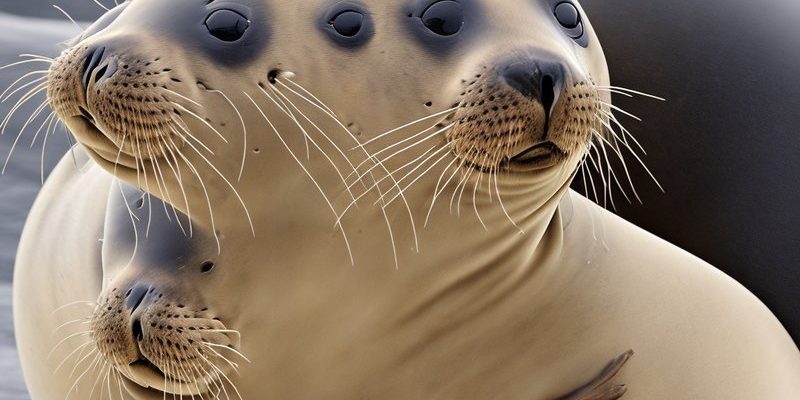![Seal Vs. [Similar Species] - Key Differences](https://gudri.com/wp-content/uploads/2025/06/Seal_Vs___Similar_Species______Key_Differences_image_0.jpg)
At first glance, these two might seem pretty similar, but dive a little deeper, and you’ll see some fascinating differences. Both belong to the pinniped family, which means “flipper-footed.” Think of them as cousins in a big, aquatic family reunion. In this article, we’ll explore their distinct traits, behaviors, and habitats, helping you understand why these creatures are more different than they seem.
Physical Differences: Shapes and Sizes
One of the biggest giveaways when it comes to telling seals and sea lions apart is their physical appearance. Sea lions are generally larger and more robust. An adult male can weigh up to 850 pounds and reach up to 8 feet in length! In contrast, seals tend to be a bit smaller and rounder, with a hefty adult male weighing around 600 pounds and measuring only about 6 feet long.
But it’s not just about size. Sea lions have visible ear flaps, which gives them a more expressive face. They also have a more pronounced snout, making them look a bit more dog-like. Seals, on the other hand, sport small holes for ears, which can be tricky to spot unless you’re up close. Their snouts are shorter and blunter, adding to their unique charm.
Locomotion: Movement in Water and on Land
Now, let’s talk about how these animals get around. Sea lions are much more agile on land. They can rotate their hind flippers forward, making it easier for them to walk and run around. Watching a sea lion shuffle and hop on land can be both funny and fascinating!
Seals, however, are more like the couch potatoes of the pinniped family. Their bodies are built more for swimming than for walking. They can’t rotate their hind flippers, so they wriggle on their bellies when they’re on land, which can be quite a sight. This difference in movement is crucial for their survival, as it affects how each species hunts and escapes from predators.
Habitat Preferences: Where Do They Live?
Habitats also play a significant role in distinguishing seals from sea lions. Sea lions typically prefer warmer coasts and can be found basking on rocky shores. They often hang out in larger groups, which scientists call “colonies.” These colonies can consist of hundreds, if not thousands, of individuals, making for a lively atmosphere.
Seals, however, generally prefer to live in colder waters. They often sunbathe on ice floes or rocky beaches in smaller groups. Since they thrive in cooler climates, you’ll find species like the harp seal making their home in the Arctic regions, while sea lions are more common along the coastlines of North America and in the Galápagos Islands.
Social Behavior: Living Arrangements
You might be wondering about how these creatures interact. Sea lions are known for being quite social. They often engage in vocalization and play, using barks and growls to communicate with one another. Their playful behavior adds to their spot as crowd favorites at aquariums and marine parks.
Seals, on the other hand, are typically more solitary. While they may gather in small groups to mate or rest, they are less vocal and social than their sea lion cousins. Instead of barking or playing, they usually prefer a quiet life, basking in the sun while keeping an eye out for danger.
Diet and Feeding Habits: What’s on the Menu?
Hungry yet? Let’s talk food. Both seals and sea lions have similar diets, primarily feasting on fish and squid. However, there are some differences in their hunting techniques. Sea lions are known to dive deep and pursue fast-moving prey using their speed and agility. They can hold their breath for up to 20 minutes while hunting, which is pretty impressive.
Seals, in contrast, tend to hunt in shallower waters and rely more on stealth. They might stay still to ambush unsuspecting fish. Some species, like the leopard seal, even hunt penguins and other seals. They’re like the stealthy ninjas of the ocean, sneaking up on their prey while remaining largely undetected.
Reproduction: A Closer Look at Their Family Lives
When it comes to family life, both seals and sea lions have interesting reproductive behaviors. Sea lions typically breed in colonies during the summer months. Males will establish territories and compete for females, often displaying some pretty impressive vocalizations and physical posturing.
Seals, however, have different breeding habits. They tend to be more monogamous during the breeding season, with many species forming long-term bonds. After a gestation period of about 11 months, female seals usually give birth to a single pup, which they care for until it’s strong enough to hunt on its own.
Conservation Status: Protecting Our Ocean Friends
Lastly, let’s touch on conservation. Both seals and sea lions face threats from climate change, habitat destruction, and fishing practices. While sea lions have made a comeback in certain areas due to conservation efforts, some seal species are still struggling and are classified as endangered.
Organizations around the world are working hard to protect these fascinating creatures through rehabilitation, education, and habitat conservation. It’s important for us to be aware of their plight and play our part in ensuring these unique animals continue to thrive in our oceans.
In conclusion, seals and sea lions may share a common family tree, but they have distinct characteristics that set them apart. From their physical differences and habitats to their social behavior and hunting techniques, both animals bring something unique to the marine ecosystem. So next time you see one of these adorable creatures, take a moment to appreciate their differences and the incredible world they inhabit.

